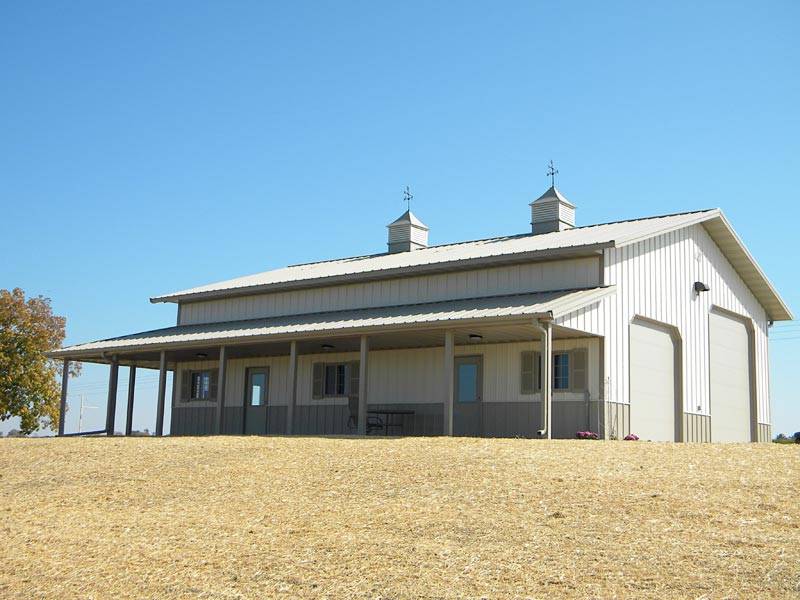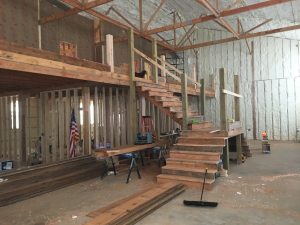Welcome to Ask the Pole Barn Guru – where you can ask questions about building topics, with answers posted on Mondays. With many questions to answer, please be patient to watch for yours to come up on a future Monday segment. If you want a quick answer, please be sure to answer with a “reply-able” email address.
Email all questions to: PoleBarnGuru@HansenPoleBuildings.com
DEAR POLE BARN GURU: You’ve convinced me of the superiority of your sistered double truss arrangement and hanger attached purlins, but I was wondering how gable endwall overhangs are accomplished with this system. You can’t just extend the last bay’s set of purlins, or use outlookers as in stick construction, so how is it done? Thanks! JEFF
DEAR JEFF: I’m glad I’ve been able to convince you of what both scientific research and real life experience has proven to be an excellent structural solution. Hands down my most widely read article has been on pole barn truss spacing:
https://www.hansenpolebuildings.com/blog/2011/06/pole-barn-truss-spacing/
Because pole buildings do not have bearing walls, (unlike stick frame construction), the trusses on the endwalls of the building can be set to a different height than the interior trusses. This allows for them to be lowered far enough so the roof purlins in the end bays with overhangscan be run across the top of the end truss. This makes for endwall overhangs which are not “cobbled together” and assurance of straight lines.
Some considerations:
Assuming a building with trusses and columns every 12′, the interior trusses will be designed for a pair of trusses to support 12 feet of roof (or a tributary area of six feet per truss). The end truss supports 1/2 the distance to the first pair of trusses (six feet in this example) PLUS the length of the overhang past the end of the building. Having to also support the overhanging distance is widely overlooked by Building Designers, builders, truss manufacturers and Building Officials.
The end truss will need to be lowered by the thickness of the roof purlin ADJUSTED FOR THE SLOPE OF THE ROOF. This is a difficult concept for most people to grok (absorb). With 2×6 roof purlins (which measure 5-1/2 inches in height), the end trusses need to be lowered by 5-13/16″ in order to keep a smooth roof plane.
Purlins should be attached to the top chord of the end truss by use of an engineered mechanical hanger, to prevent uplift. In most cases a Simpson H-1 is adequate to withstand those loads (however it should be confirmed by a RDP (Registered Design Professional – engineer or architect).
Read https://www.hansenpolebuildings.com/blog/2013/08/simpson/to find out from real life experience why this is a good idea.
Solid blocking should be placed between the purlins, on top of the end truss. This will prevent flying critters from making your building their new home, as well as providing a point for attachment of any soffit panels for enclosed endwall overhangs.
Mike the Pole Barn Guru
DEAR POLE BARN GURU: Live 2 hours north of Toronto Ontario Canada. Building a wood shed with a storage shed attached to it. Our soil has poor drainage with lots of clay. Using milled cedar 6″ by 6″ posts. What would you treat the posts with? I was thinking roofing tar. I am going to sink them in about 5 feet to avoid any frost issues. Should I back fill with gravel soil mix or concrete them in. Very confusing with all the different answers out there. Building will be about 20′ by 20′. Would enjoy hearing your response and any help you could offer. Thanks. KELLY IN LINDSAY, ONTARIO
DEAR KELLY: While cedar has some natural resistance to decay, it is just not going to afford the lifespan of a properly pressure preservative treated timber.
You should be looking for treated columns which have a minimum rating of UC-4B (https://www.hansenpolebuildings.com/blog/2014/05/building-code-3/).
Provided the posts are milled to a 5-1/2” x 5-1/2” dimension, you could alternatively use Plasti-Sleeves with them https://www.hansenpolebuildings.com/blog/2012/04/plasti-sleeves/ to help prevent future decay.
It is important to have the bottom of the holes below the frost line. There should be a concrete footing below each column of at least eight inches in thickness, as well as 10 inches or more of concrete up the sides of the column to help resist uplift.
Mike the Pole Barn Guru
DEAR POLE BARN GURU: I am moving to Reno, NV…. out in the wood!!! Not in town. You have to be a qualified to do the required Engineering FOR NV. Are you able to do so????
I think it is DUMB for them to require this…. but it is a mandatory req. please get back with me ASAP or call me. THANKS >>> TONY
DEAR TONY: Washoe county is a stickler for requiring engineering in order to acquire building permits. We’ve done several buildings in the county, and our engineers are registered in every state – the answer to your question being YES we can do so.
Why is requiring engineering not dumb? Because buildings designed using seat-of-the-pants engineering tend to fall down and destroy personal property, as well as hurt, maim, or kill occupants – none of which is good.
Mike the Pole Barn Guru
DEAR POLE BARN GURU: What is meant by “steel offloading” as an option? BECKY IN AKRON
DEAR BECKY: For buildings with steel roofing and/or siding, these materials will arrive at your building site on what is known as a route truck. Your order is very probably one of a huge number on the truck and trailer, which is loaded very close to its 80,000 pound maximum capacity when it leaves the plant.
The truck will make many stops and orders are loaded so the first delivery is on top, etc. As many of the deliveries are at lumber yards, or to builders or others who have adequate equipment to offload the steel, they are not charged for the driver to use his offloading machinery.
If you do not have the ability to safely offload, then for a nominal charge the steel company will unload for you. This does have to be scheduled in advance – as the steel company may otherwise load your order onto a truck which does not have offloading capabilities.
Mike the Pole










Is a tractor with forks capable of lifting a full pallet of concrete (3-4K lbs) sufficient to offload steel or other typical pole barn loads? Are the loads palletized in such a way that a single fork can offload them (i.e., not super long).
In the great majority of cases the only materials of consequence which will need to be unloaded will be the skids of steel roofing and/or siding. They are placed upon skids, usually weighing 1500-2000# and are designed to be unloaded with adequate capacity lifting equipment.